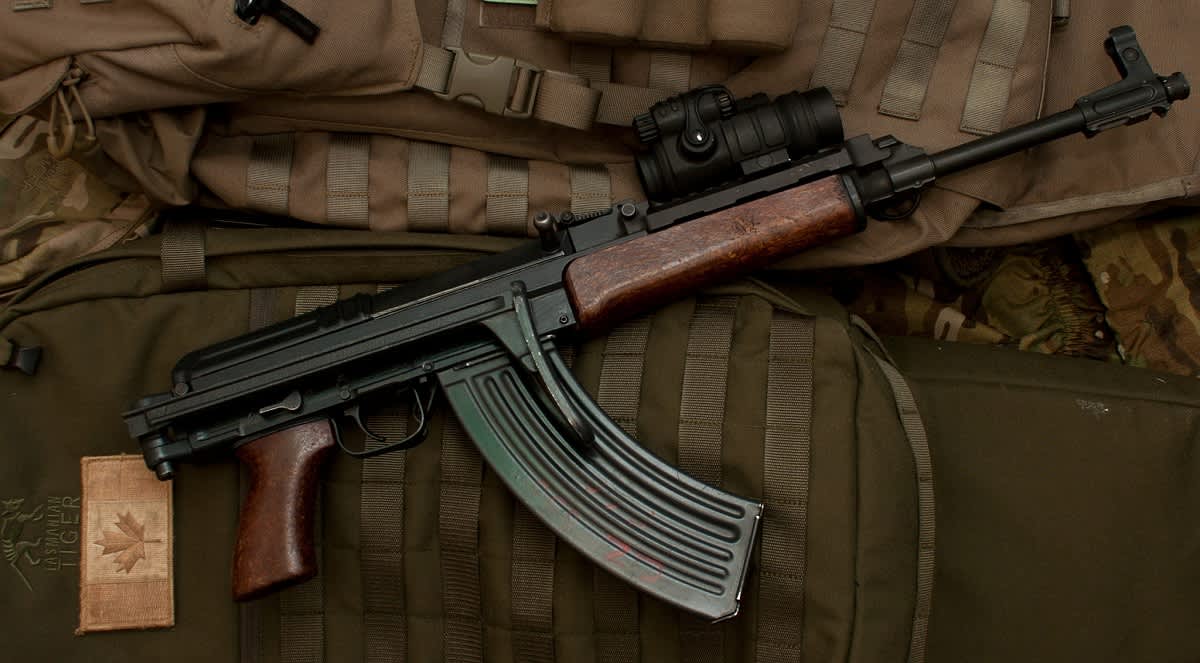The Czech vz. 58 Rifle: The Kalashnikov’s Superior Cousin
Edward Osborne 12.09.14

The 7.62x39mm Czechoslovakian samopal vzor 1958 (frequently referred to as the vz. 58) is often overshadowed by the Kalashnikov-pattern rifles that many Eastern Bloc nations adopted during the Cold War. Despite their external similarities, the firearms that make up the vz. 58 family are actually dramatically different from the AK dynasty. In addition to the physical differences, vz. 58-pattern firearms sport several unique features that set them apart and above the venerable AK.
When the USSR decided to standardize use of the 7.62x39mm cartridge for all Warsaw Pact countries, most nations decided on AK-pattern guns. Czechoslovakia opted to produce its own line of small arms. The only part shared between the vz. 58 and the widely produced AKM is their ammunition.
There are few other firearms “natively” chambered in 7.62x39mm beyond the Kalashnikov and vz. 58. There’s the SKS carbine and RPD light machine gun, but that’s about it. Many other gun platforms have been reworked to chamber the cartridge, but few were designed from square one to run 7.62x39mm.

The vz. 58 was developed by Jiří Čermák in 1956, was formally adopted by the Czechoslovak army in 1958, and began being issued in 1959. The rifle is still in use today by Czech and Slovak forces and has seen combat in Iraq and Afghanistan over the last decade. That means the vz. 58 has seen deployment in various configurations for 55 years and counting.
The famous AK was designed by Mikhail Kalashnikov in 1946 and adopted by the Soviet army in 1949. Entire books have been written about the design and dissemination of the Kalashnikov, arguably the most prolific intermediate-caliber, centerfire rifle of all time.
While it’s estimated that between 75 and 100 million AK-platform rifles have been churned out by a number of different manufacturers, the final count of vz. 58s made is likely near the 1 million mark. While the initial military run ended in 1984 with approximately 900,000 rifles produced, companies like Czech Small Arms are producing new semiautomatic-only receivers for the civilian market today.
Below you can see a diagram of external differences, but the key identifier is the triangular bolt carrier group of the vz. 58 and its gigantic ejection port.

Internally, the vz. 58 is a drastic departure from the AK.
The initial rifle featured some surprisingly modern designs, and reflects a well-thought-out manual of arms.
The Kalashnikov action uses a long-stroke gas piston (the bolt carrier group and the piston all move together as a single unit), while the vz. 58 uses an unconventional short-stroke gas piston (the piston smacks the carrier group to move it, but they are not attached to each other) with only a short length of travel. Rather than using the hammer system so common in most triggers, the vz. 58 is striker-fired (that’s right, like your Glock)—a rarity in any semiautomatic rifle.

Unlike the Kalashnikov, the vz. 58 was designed from the get-go to use a bolt hold-open device. When the last round in the magazine is fired, the action locks back, which alerts the shooter that they’ve run empty. Standard doctrine says this is when the shooter removes one magazine and inserts another, but the vz. 58 has another trick up its sleeve—the bolt carrier group has a feed ramp for stripper clips, so that ammunition can be fed directly into the magazine when the bolt is locked open. It’s not exactly high-speed, low-drag, but the idea was that if all the magazines were emptied, this was a fast alternative to get crated ammunition back into the rifle.
You can see me tinkering with it here:
The vz. 58 has always used a milled billet receiver, while various AK platform rifles throughout the years have been stamped or milled. The Czech guns are very lightweight—a fully-loaded factory vz. 58 weighs 7.9 pounds, while a fully-loaded AKM weighs 10.5 pounds.
Many vz. 58s were fitted with a skeleton-style folding stock from the factory.
Mounting optics can be a challenge for users of both rifles, neither Čermák or Kalashnikov seem to have anticipated the widespread adoption of magnified optics and red dot sights.
A simple side-mounted rail system is available for both rifles that allows a variety of sights to be mounted. If you’re looking for Picatinny rails, there are several companies producing railed optic mounts (like RS Regulate). Generally, most companies that produce AK accessories and parts will have some vz. 58 offerings in their lineup as well.

In one form or another, the vz. 58 has seen use in 20 different militaries and numerous civilian roles. The AK retains a much wider user-base, with a presence in over 110 countries around the world, plus plenty of non-state actors and rebel groups.
For the sport shooter or collector, vz. 58-pattern rifles are remarkably affordable. While a newly manufactured short-barreled PDW in .223 might have a $1,000 price tag, a refurbished semi-auto rifle using military parts can be had for as low as $400 in the United States.
Though it may not get as much love as other modern rifles, the vz. 58 has its niche. My vz. 58s, chambered both 7.62x39mmm and .223, see more use outside the safe than almost any of my other guns.

